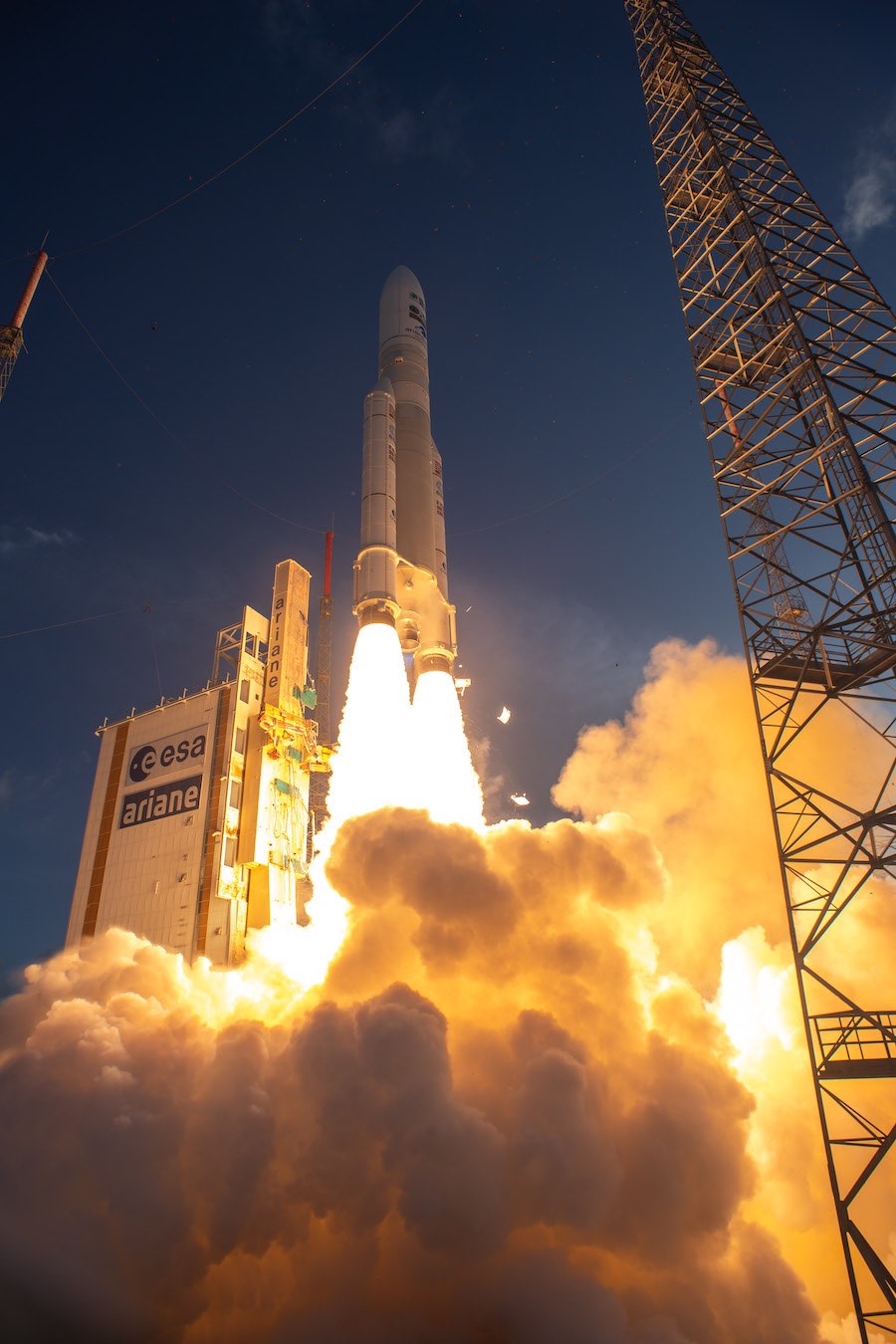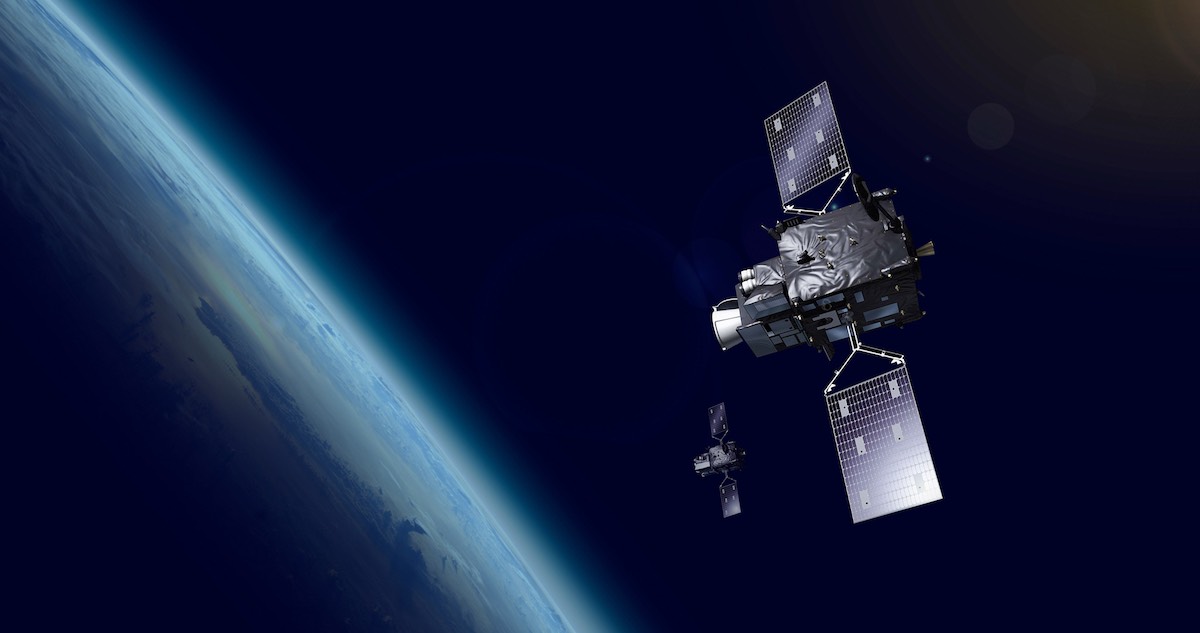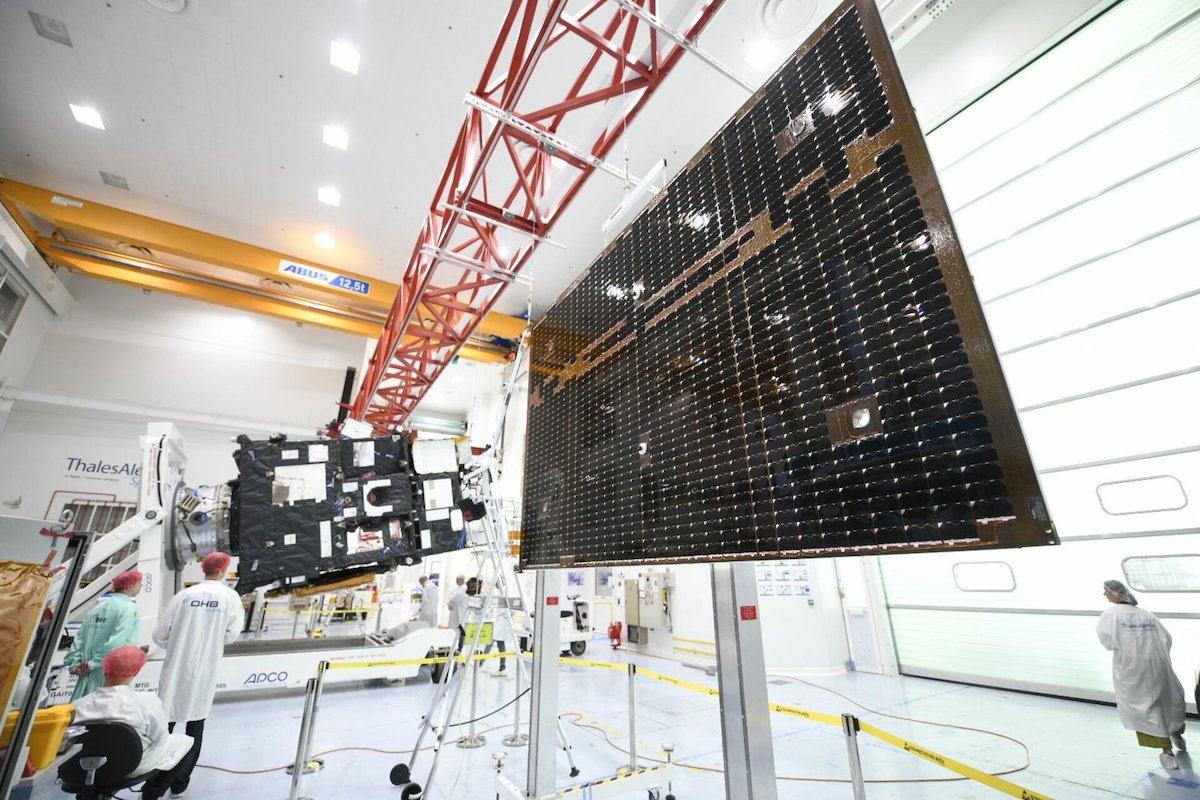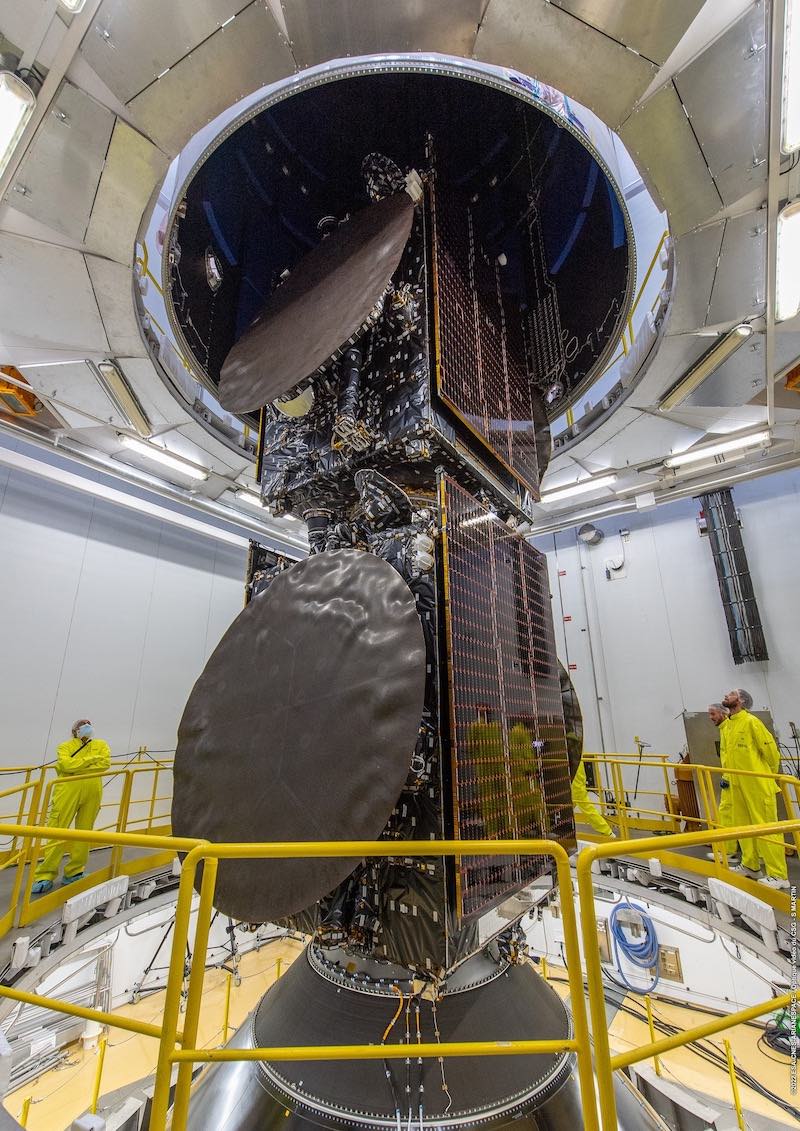Space News & Blog Articles
Ariane 5 rocket launches new European Meteosat satellite, two Intelsat comsats
 A European Ariane 5 rocket blasts off from Kourou, French Guiana, on Tuesday with Europe’s MTG-I1 weather satellite and Intelsat’s Galaxy 35 and 36 communications satellites. Credit: ESA–M. Pedoussaut
A European Ariane 5 rocket blasts off from Kourou, French Guiana, on Tuesday with Europe’s MTG-I1 weather satellite and Intelsat’s Galaxy 35 and 36 communications satellites. Credit: ESA–M. Pedoussaut
A European Ariane 5 rocket fired off a launching stand Tuesday in tropical South America with the vanguard of a modernized series of weather satellites to improve storm forecasts for Europe, Africa, and the Middle East, and two Intelsat television broadcasting satellites to cover the United States, a heavyweight payload totaling more than 24,000 pounds (about 11 metric tons).
After a smooth on-time countdown, the 185-foot-tall (56.4-meter) Ariane 5 lit its hydrogen-fueled, French-built Vulcain 2 engine when the countdown clock struck zero at 3:30 p.m. EST (2030 GMT) Tuesday. After the engine passed an automated health check, the rocket’s twin solid-fueled boosters ignited seven seconds later to propel the launcher off the pad at the Guiana Space Center on the northeastern coast of South America.
The rocket vaulted off the launch pad and arced east from French Guiana over the Atlantic Ocean, surpassing the speed of sound in less than a minute as the boosters and core stage engine combined to generate 2.9 million pounds of thrust.
The strap-on boosters burned out and jettisoned a little more than two minutes into the mission, and the Swiss-made nose cone on top of the Ariane 5 separated about a minute later to reveal the three satellite payloads to the space environment after the rocket soared above the dense lower layers of the atmosphere.
The core stage shut down its main engine nearly nine minutes into the mission, then fell away to head for a destructive re-entry in the Gulf of Guinea off the west coast of Africa. The Ariane 5’s cryogenic upper stage, assembled in Germany, ignited its HM7B engine for a 16-minute firing to place the Meteosat weather satellite and Intelsat’s Galaxy 35 and 36 communications spacecraft into an elliptical geostationary transfer orbit.
The targeted orbit for the three satellites ranged as far as 22,316 miles (35,915 kilometers) from Earth, with an orbital plane inclined 6 degrees to the equator.
Liftoff of Europe’s Ariane 5 rocket on its third to last mission, powering into geostationary transfer orbit with a new-generation Meteosat weather satellite and two Intelsat TV broadcasting spacecraft. https://t.co/3y0hQt6UO7 pic.twitter.com/PkwCj7XsNo
— Spaceflight Now (@SpaceflightNow) December 13, 2022
The Galaxy 35 and 36 satellites, built in California by Maxar, were stacked on top of the other for launch in the upper position of the Ariane 5’s payload compartment. Ariane 5 rockets typically launch two large satellites per mission, but engineers added a riser to the connection between the upper stage and the payload fairing to create more volume for three payloads on Tuesday’s flight.
Below Intelsat’s Galaxy satellites, cocooned inside a carbon composite payload adapter structure, was Europe’s first Meteosat Third Generation weather satellite, developed in partnership between the European Space Agency and Eumetsat, Europe’s weather satellite agency consisting of 30 member states.
Galaxy 35 deployed from the rocket first, about 27-and-a-half minutes after liftoff, followed by the release of Galaxy 36 nearly 31 minutes into the mission. The composite payload adapter separated next, exposing the Meteosat satellite satellite for deployment nearly 35 minutes after launch.
Officials from Arianespace, the Ariane 5’s operator, declared the launch a success. It was the 259th launch by a rocket in Europe’s Ariane launch vehicle family since 1979, and the 115th flight of the Ariane 5 version since 1996.
“With the successful launch of VA259, Arianespace is proud to serve the interests of Eumetsat and Intelsat, two operators with whom we have been working since 1981 and 1983, respectively”, said Stéphane Israël, CEO of Arianespace. “This mission serves both Europe and North America and is a perfect illustration of the versatility of our heavy-lift launcher, which is capable of meeting the needs of both institutional and commercial operators. Its passengers also reflect our own values, which are to make space work for a better life on Earth, by improving our meteorological knowledge and connectivity.”
Officials from Maxar and the European Space Agency confirmed ground teams in California and Italy established contact with all three satellites. Each of the spacecraft extended their power-generating solar panels Tuesday evening.
 Artist’s concept of Meteosat Third Generation satellites in orbit. Credit: Eumetsat
Artist’s concept of Meteosat Third Generation satellites in orbit. Credit: Eumetsat
Galaxy 35 and 36 will use their own propulsion systems to reach a circular geostationary orbit more than 22,000 miles (nearly 36,000 kilometers) over the equator, a process that will take a few weeks using a series of thruster firings to reshape its orbit. The satellites will enter service early next year to provide C-band television broadcast services over the United States, part of a transition mandated by the Federal Communications Commission to free up a slice of the C-band spectrum for terrestrial 5G broadband connectivity.
The transition to 5G requires satellite operators like Intelsat to build and launch new satellites to maintain their C-band programming for cable TV networks in the United States. The new C-band satellites are designed to operate in a more narrow segment of the C-band spectrum, permitting other frequencies to switch over to 5G services.
The Galaxy 35 and 36 satellites are designed for 15-year missions to replace aging members of Intelsat’s fleet launched in 2002 and 2005 and operating at 89 degrees west and 95 degrees west longitude. Galaxy 35 and 36 are the fifth and sixth new C-band satellites Intelsat has launched this year. Four new Intelsat C-band spacecraft launched on a pair of SpaceX Falcon 9 rockets earlier this year, and a seventh and final new C-band payload will launch on a SpaceX mission in 2023.
“Our Galaxy 35 and Galaxy 36 satellites are part of our North American fleet refresh,” said Jean-Luc Froeliger, Intelsat’s vice president of space systems. “They’ll be used by media customers to provide live broadcasting of news, entertainment and sports events.”
The weather satellite launched on the Ariane 5 rocket Tuesday is the first of six spacecraft in Europe’s 4.3 billion euro ($4.5 billion) Meteosat Third Generation, or MTG, program. It is heading for a position in geostationary orbit to begin a planned eight-and-a-half-year service life parked at the intersection of the equator and the prime meridian — 0 degrees latitude and 0 degrees longitude — centered over a point south of the Ivory Coast.
The first MTG satellite carries a rapid-scan imaging instrument, a lightning detector, and radios to support search and rescue services. The spacecraft will be renamed Meteosat 12 after it enters service next year, becoming the primary source of satellite weather observations for real-time forecasting in Europe and Africa.
The MTG program will consist of four imaging satellites, known as MTG-I missions, to look at movements of storm systems, weather fronts, and lightning. There will also be two Meteosat Third Generation spacecraft with infrared sounders, called MTG-S missions, to measure temperatures, moisture, and other parameters throughout Earth’s atmosphere.
 The first imaging satellite in Europe’s Meteosat Third Generation series, called MTG-I1, unfurls its solar panels during testing at a Thales Alenia Space clean room in Cannes, France. Credit: ESA–M. Pedoussaut
The first imaging satellite in Europe’s Meteosat Third Generation series, called MTG-I1, unfurls its solar panels during testing at a Thales Alenia Space clean room in Cannes, France. Credit: ESA–M. Pedoussaut
The satellite launched Tuesday is called MTG-I1.
MTG-I1 will go through a similar series of post-launch maneuvers as Intelsat’s satellites and settle into geostationary orbit for up to one year of commissioning and testing at 3.5 degrees west, before moving to its final position at 0 degrees longitude when officials entrust it to provide crucial data for weather forecasters.
“The MTG program is undoubtedly a European success,” said Phil Evans, director general of Eumetsat. “It’s relied on the expertise of Eumetsat, ESA, and a wide range of European industry in a multibillion-pound project, and is one of the most complex and advanced satellites currently being developed.
“MTG-I, specifically, will focus on the detection of rapidly developing extreme weather events, such as storms, which have the biggest impact on our society,” Evans said in a pre-launch press conference. “It will provide us higher resolution data, better quality data, and in fact, will provide our users with over 50 times more data than is currently available.”
Thales Alenia Space of France led the pan-European contractor team that developed the MTG-I1 satellite. OHB System AG, a Germany company, supplied the satellite structure itself. Thales also developed the Flexible Combined Imager, the MTG-I1 spacecraft’s primary weather sensing payload. The Italian company Leonardo provided the Lightning Imager instrument.
The Meteosat Third Generation satellites will replace Europe’s Meteosat Second Generation, or MSG, satellites that launched from 2002 through 2015. Europe’s first Meteosat weather satellite launched in 1977, and MTG-I1 will be the 12th Meteosat to launch in the program.
The upgrades on the new generation of Meteosat satellite include the Flexible Combined Imager, which will collect and transmit images of rapidly-evolving storms over Europe every two-and-a-half minutes, half the time it takes to take a picture over Europe with the currently operating Meteosat satellites. MTG-I1 will update its view of Africa every 10 minutes, an improvement over the 15-minute imaging cadence now available for that region.
The MTG imaging instrument also has 16 channels in visible and infrared wavelengths, instead of the 12 available on the current satellites, giving it the capability to see more detail in cloud temperatures and structure. And the imager’s resolution is also improved on the Meteosat Third Generation satellites, providing sharper views of clouds and storms.
“I think it’s important to recognize that very, very intense, very localized severe weather — the sort of thing that might affect a village or a town, but is very local — is incredibly hard to forecast,” Evans said. “Even with the best of computers and the best science, it’s still really challenging. The observations from a satellite like this give us a real chance to give people reasonable amounts of warning for the most devastating weather.”
 Intelsat’s Galaxy 35 (top) and Galaxy 36 (bottom) television broadcasting satellites during encapsulation inside the Ariane 5 rocket’s payload fairing. Credit: Credit: ESA/CNES/Arianespace/S. Martin
Intelsat’s Galaxy 35 (top) and Galaxy 36 (bottom) television broadcasting satellites during encapsulation inside the Ariane 5 rocket’s payload fairing. Credit: Credit: ESA/CNES/Arianespace/S. Martin
The new generation of European weather satellites will provide more advance warning of thunderstorms, tornadoes, and flooding rainfall. The Meteosat satellites are also used to track wildfires, volcanic ash, and ice clouds in the upper atmosphere that could impact aviation.
“We need better short range forecasts, looking at the next few hours ahead, to help emergency responders to to take the correct kind of action, both to put their resources in place when they need to respond to incident, and also to give them a heads-up when the worst of the weather has passed so they can begin the recovery effort,” said Simon Keogh, head of space applications and nowcasting research and development at the UK Met Office.
The first MTG Sounder satellite is scheduled for launch in late 2024, and a second MTG Imager satellite is slated to blast off in 2026. Two more imaging satellite and one more sounding satellite will launch in the early 2030s to maintain coverage through at least 2040.
“With these satellites coming together, we’ll be able to monitor, for the first time, the atmospheric conditions, which are the precursor to a severe weather event, severe weather events rising actually as they occur, and the most intense places through the lightning images,” Evans said.
Eumetsat provided most of the funding for the six-satellite MTG program, paying for the design of the overall system, launch services, operations, and data exploitation. ESA managed the procurement of the satellites.
“It has taken longer than we hoped,” said Paul Blythe, ESA’s Meteosat program manager. “When you’re developing these technologies, we get surprises. By definition, if we are pushing the edge, sometimes the edge bites us, and we’ve had two or three developments, particularly on optical coatings, we had some challenges, and on detectors, we had some challenges.”
If the post-launch tests go according to plan, Eumetsat expects MTG-I1 — soon to be Meteosat 12 — to be ready for operational service by the end of 2023.
The Meteosat satellites are similar to NOAA’s GOES weather satellites that cover the Americas, and Japan’s Himawari geostationary observatories over the Asia-Pacific region.
The launch Tuesday will mark the third-to-last flight of Europe’s workhorse Ariane 5 launch vehicle. Two more Ariane 5s are left to fly in 2023 before the transition to the next-generation Ariane 6 rocket.
It was the final launch on an Ariane 5 rocket for Intelsat, one of Arianespace’s most loyal customers. Arianespace has now launched 64 Intelsat satellites.
“We started our cooperation in 1983, and since then we’ve used Ariane 1, Ariane 2, Ariane 3, Ariane 4, and Ariane 5,” Froeliger said. “This is our last Ariane 5 launch, so it’s time to say goodbye, farewell, thank you Ariane 5. And we will be back, so see you soon Ariane 6.”
This email address is being protected from spambots. You need JavaScript enabled to view it. the author.
Follow Stephen Clark on Twitter: @StephenClark1.
When you subscribe to the SpaceZE News Feed, we will send you an e-mail when there are new updates on the site so you wouldn't miss them.

